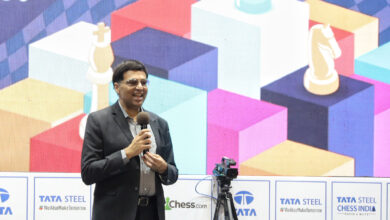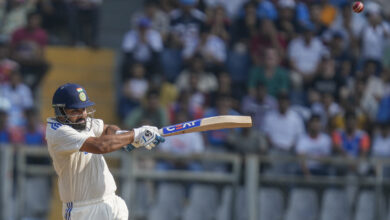Fencing Nationals: For Indian fencers, sharing kits and equipment are thing of the past… well almost

Pune: As struggles of procuring equipment get relegated to nostalgia amongst reuniting athletes at Pune’s Balewadi stadium, the Fencing Nationals in India wear a slick look of professionalism.
Days of shared kits aren’t completely in the past, but receding slowly as the various schemes of SAI, Khelo India, Universities, state governments and nonprofits equip fencers with up-to-date gear.
Still, Ena Arora of Patiala recalls how Ajinkya Dudhere, her senior from Maharashtra, brought her the first proper blade. “In juniors we used to use Chinese weapons, which were highly inconsent in flexibility but affordable. They used to be so hard, there would be marks on the neck and I’d get asked in school if someone had been violent towards me!” Arora remembers. “Whenever anyone got selected for internationals, he would travel with a l of things needed others because there would be stalls of equipment makers.”
These fencing Santas didn’t wait until Chrmas.
Every fencer has old tales of sharing kits, and even organisers in India being considerate enough and waiting for a fencer to borrow the gear and get pe-ready with as many as eight fencers sometimes having to make do with one set of equipment. Dnyaneshwari Shinde of Latur recalls having to run bare-feet across arenas, before wearing the necessary boots. “I always carried wads of cotton. The boys’ shoes would invariably be too big, so I’d stuff the toes with cotton to make them fit,” she says.
Alien feeling
Ajinkya himself remembers fashioning swords out of cane sticks and banyan roots to practice with, because for the first four years he couldn’t find equipment needed for a southpaw. “I’ve done the entire chain of things in fencing from using cane sticks to borrowing gear, paying Rs 2000 deposit and being happy if they returned Rs 1500 because that meant everything was in order and nothing was broken!”
Perhaps the biggest worry in fencing when kits get borrowed is about something coming apart, and then having to shell out the whole amount – just for the love of sport. Vamshi, a talented epee fencer who’s 20 but not supported any of the schemes, dreads borrowing equipment. “If you have your own kit, you fence confidently. If you borrow you have to be very careful that nothing breaks. Otherwise you have a hole in the pocket for 15-20 thousand straight away,” he says.
Hailing from Hyderabad, his parents have been supporting his expensive dream. Though he had decent results at an Uzbekan World Cup he’s not sure how he’ll sustain fencing for much longer. “I still don’t have my kit and have to depend on friends to lend me socks, bodywear and masks. But it doesn’t feel like my game when I borrow,” he says.
Most Indians in the sport come from middle-class families, having gotten the fencing bug when they watch it at school demos. The sport with its attractive white gear and its vaguely French elegance, can prove too swooningly appealing, but is a monster drain on parents’ pockets.
“Poora India ghumaa diya ladki ne,” laughs Jagmeet Kaur’s father from Gurdaspur, who couldn’t say ‘No’ whenever she needed financial help to continue in the sport she was smitten at age 12. Her Amritsar university supports her now, but monetary resources have been draining. “This one time I was at a tournament and had bad water and came down with jaundice, ending up in a hospital for a month. So it’s not just equipment. The travel costs and living costs are high. You need 2-2.5 lakh per international trip, and four years of many such trips to qualify for the Olympics. It’s very tough,” Jagmeet says of what are prohibitive costs. Yet she perss, and earned herself a final against Bhavani Devi at the National Games final recently.
Her equipment peeve? “I hoarded my stuff one piece at a time asking those going abroad to buy. But in fencing, stuff is likely to bend and break, so it’s a constant struggle,” she says. “But I remember competition directors being understanding as our kit relays – passing from one to another – would go on comically with people running around collecting their gear. They would say, ‘We’ll wait’.”
“It was pretty common earlier, for 3-4 people to share two kits,” recalls sabre fencer Kashish Bharad of Aurangabad. They could even walk up to strangers and ask to borrow, and the fencing community understood and would help. It even had an unofficial word like jugaad. It was called ‘to adjust”.
“Fencing has changed a lot now. If you get picked the schemes, then they help with equipment,” says Haryana’s epee sensation, Prachi who’s supported multiple benevolents.
Otherwise, costs can go from INR 7000 to INR 70000. KP Singh, renowned fencing coach with Services, recalls a time in the 1990s when there were hardly any dealers selling fencing equipment, let alone personal gear. Fencing started in 1974, but got into the SAI program only in 1989 under Special Areas Game. “And importing would be equivalent to a month’s salary back then! Now look at the Nationals. There’s personal kits, pe, video analysis!”
For Pooja Dangi of Madhya Pradesh, a personal kit meant the world. “Most Indian fencers fall in love with the game without thinking of the cost. Equipment is shared because you think ‘I’m not good enough a player so i won’t buy my personal gear.’ The day I got my own gear from a scheme, I knew I’m a good fencer now.”







